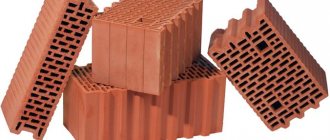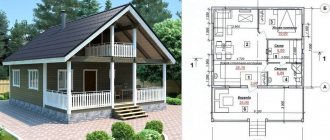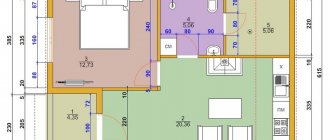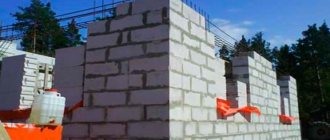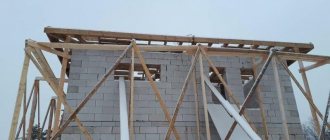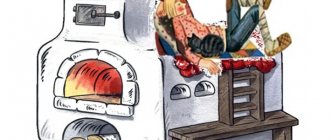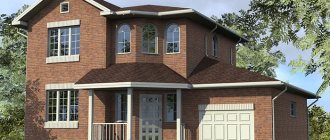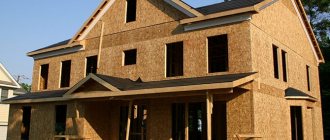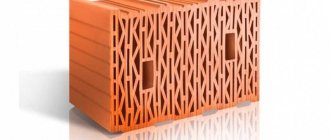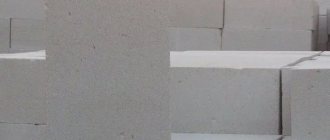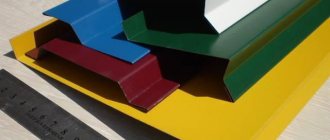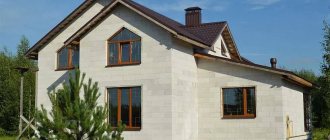Today we will talk about another high-tech building material, which has recently become very popular, even despite its relatively high prices. Ceramic blocks, also called ceramic blocks, are another alternative to brick, having their own advantages and disadvantages. We will describe both of them in this article, as well as list the customer reviews that most accurately characterize this material.
The basis for this material is clay. Small wood shavings are added to the latter. After the block is exposed to temperature, the wood simply burns out, leaving behind voids that greatly lighten the finished product, but do not reduce its technical characteristics compared to ordinary bricks, also made from clay.
Maybe there is such a thread, but I haven’t found anything. I would like to know which of these materials you would prefer, it is clear that each of them has its own pros and cons. The house is approximately 8x8 on two floors. I am sure that there are people who are this The period has long been crossed and experience has accumulated. Thank you. Yes, please don’t kick too hard.
Well, thank God, at least some kind of construction topic appeared on the thread about construction. )) Good question...but most importantly there is no answer to it. )) Everyone chooses based on their own conditions. Let's start with aerated concrete: you just need to understand that we are talking about autoclaved aerated concrete and nothing else (such as foam block or non-autoclaved gas silicate) Advantages: the main advantage is that it is a structural and heat-insulating material.. thermal conductivity (0.12-0.14) .. load-bearing capacity 28 kg/cm2 Easy to process and cut. relatively inexpensive price.. What do these advantages provide? This is an opportunity to make single-layer walls (without insulation). and as you know, a single-layer wall is always better than a multi-layer one.. Disadvantages: the obligation to follow the technology recommended by the manufacturer (laying with glue, reinforcing rows in grooves, installing reinforced belts)
Porous brick..advantages - ease of masonry, relatively good thermal insulation (thermal resistance of TC (warm ceramics) is the same as that of GB (gas sides), but since TC is placed on the mortar, the thermal resistance of TC masonry is inferior) It is not necessary to reinforce the rows and it is not necessary to install an armored belt ( although it is desirable) High load-bearing capacity compared to GB Disadvantages: Price.. Fragility (for me the big disadvantage is the large amount of waste remaining after construction.. but if you lay it yourself, you may be more careful..) More difficult to saw (compared to GB) I won’t sing songs about environmental friendliness, since there is no serious data.. I also won’t attribute the image component to TC, the sales people do it well.. I also don’t consider gossip about the fragility of GB.. since there are houses that are 50 years old. .personal experience of five years of communication with this material is also positive.
What do these materials have in common? This is one thing... The use of these materials is advisable if you make a wall without insulation... if you want to insulate the wall, then in both cases it’s money down the drain...
And if we talk about personal feelings. TC is a good material, but unfairly overrated (cost). GB is normal, but only if you strictly follow the process technology.
Last edited by vetal m; 07/31/2015 at 19:45.
I already understood that there is no concrete answer to this question, and the more you read, the more your brain begins to boil, so I created a thread, maybe someone has already built and lived for two or three years. Well, the price for them doesn’t seem to be much different.
Last edited by LUBE; 07/31/2015 at 19:59.
Specifications
Cayman ceramic blocks are considered a serious competitor even for gas blocks: the main advantages are visible in the characteristics of warm ceramics:
- thermal conductivity – 0.082-0.084 W/mºC;
- strength – M 75-100, masonry of 1 square of this material can withstand a load of 75-100 kg;
- frost resistance – 50-75 cycles;
- NF factor – 8.6-10.8;
- weight – 12.2-14.54 kg.
The minimum values are presented for the Cayman 30 ceramic block, and the maximum for the Cayman 38 ceramic block.
Dimensions and distinctive features
There are two types of sizes in the CRRV line:
- Cayman 30. Has dimensions 255x300x219 mm.
- Cayman 38. Dimensions – 250x380x219 mm.
To make it easier to navigate the names, manufacturers put the length of each product in its name.
There are several distinctive features:
Cayman 38 does not require insulation at all; they act as an independent building material for walls;- Cayman 30 can be insulated, but this is not necessary: if insulation is still planned, then facing bricks will be sufficient;
- the patented joint prevents freezing of the wall;
- the pores and holes are small in size, so the mortar will not fall through during masonry work.
The manufacturer claims that throughout Russia this material is the best in its class and has no analogues.
Water absorption is 21%, and the average density is 707 kg per 1 cubic meter. The manufacturer claims that a wall made of these blocks using ordinary cement mortar and simply plastered will be warmer than a wall made of ordinary ceramic products.
Strength.
The strength of wall materials is determined by the maximum pressure of the distributed load on the test sample and is characterized by the number of kilograms of force (kgf) applied to one square centimeter of the surface of the material.
So ceramic block Cayman30
has a strength grade of M75, which means that one square centimeter can withstand a load of 75 kg.
The value of the strength grade of a gas silicate block with a density of 500 kg/m3, from different manufacturers, ranges from M35 to M50. As a result, according to the instructions of the manufacturers of gas silicate blocks, every third row of masonry should be reinforced, as shown in the photo below.
Ceramic block masonry Kaiman 30
reinforced only at the corners of the building, a meter in each direction. For reinforcement, a basalt-plastic mesh is used, placed in the masonry joint. Labor-intensive gating and subsequent covering of the reinforcement in the groove with glue is not required.
When installing ceramic blocks, masonry mortar is applied only along the horizontal seam of the masonry
. The mason applies the mortar to one and a half to two meters of masonry at once and places each subsequent block along the tongue and groove. The laying is carried out very quickly.
When installing gas silicate blocks, the solution must also be applied to the side surface of the blocks. Obviously, the speed and complexity of masonry with this installation method will only increase.
Also, sawing ceramic blocks is not difficult for professional masons. For this purpose, a reciprocating saw is used; gas silicate blocks are also sawed using the same saw. Only one block needs to be cut in each row of the wall.
2. The ability of the structures under consideration to resist heat transfer, i.e. keep the house warm in winter and cool in summer.
Ceramic blocks Porotherm: features and price
Porotherm ceramic blocks are a high-strength building material of a new generation, developed based on the use of innovative technological solutions and unique, centuries-old traditions of the ceramic industry. The combination of exceptional quality of large-format products, excellent strength characteristics and the possibility of reliable tongue-and-groove connections determine the ease and unsurpassed convenience of constructing multi-storey structures using Porotherm ceramic blocks.
Among other parameters that perfectly characterize such an extraordinary wall material, we can highlight:
- high sound insulation properties,
- ability to retain heat and pass steam;
- economical consumption of mortar (30-35% less);
- excellent level of thermal resistance;
- the ability to create a favorable and healthy microclimate in the house;
- a variety of dimensions that contribute to the development and implementation of completely unexpected architectural details and styles;
- the price of Porotherm ceramic blocks is competitive and affordable: on average 100 rubles per piece (3 US dollars);
- Thanks to the ability to combine different types of building and finishing materials, the blocks are successfully used for complex construction (exterior walls, interior partitions, semicircular windows, turrets and arched walls). All this provides the prerequisites for the implementation of unusual construction projects based on individual drawings using modern architectural configurations.
What is important to know before purchasing material
Construction is a rather responsible process. In order for the work to be fast and of high quality, the volume of material must be correctly calculated. The thickness of the wall will affect the calculated figures. Thus, if you want to get a wall whose thickness is 120 millimeters, then you should lay half a brick. For a wall thickness of 250 millimeters, the products need to be laid out in one brick. 380 millimeters will be obtained if the blocks are laid in one and a half bricks. 510 millimeters can be obtained by laying 2 bricks. And for a thickness of 640 meters, two and a half bricks should be laid.
Areas of application
There is not an ounce of exaggeration in the statement that from the products of a well-known brand of building materials you can build a house of any number of floors and with variable useful properties . This is indeed true, the products are used in the construction of a private house, a country mansion, a residential building on a summer cottage, in urban and rural areas, in different climatic zones. Innovative manufacturing technology, quality control and compliance with standards distinguish the products of the famous Russian brand of building materials.
Reviews about fire safety
Porous hollow brick is also used by consumers for the reason that it is fire resistant. This material can be compared to clay or silicate brick, which not only does not burn, but is also able to withstand exposure to open fire for several hours; it is this characteristic that consumers pay attention to most often. This especially applies to future owners of private country houses.
Arguments for"
Low cost
To make this obvious, we present the comparative cost of 1 m3 of masonry (in rubles) of some materials:
- expanded clay concrete – 2,250;
- foam concrete – 2,650;
- brick – from 5,500.
Although these are indicative prices, they give a general idea.
The versatility of masonry
It is understood that you can use either a traditional cement-based mortar or a (special) adhesive composition. While, for example, gas silicate blocks are held together only with special glue.
Simple technology
Firstly, this is explained by the identical (if the products are not “handicraft” made) dimensions of the blocks.
Secondly, the relatively small mass of the products makes it possible to do without lifting mechanisms. For example, a “standard” solid wall block weighs about 25 kg (390 x 190 x 188). Slotted, septal - and even less. Read more about the production process and the necessary equipment for expanded clay concrete blocks.
At the same time, there is some difficulty in processing expanded clay concrete. To cut it, you will need a saw with pobedite teeth.
The structure of the blocks allows the walls to “breathe”
This is due to the sufficient vapor permeability of the material. Consequently, the microclimate in the house will be maintained at a constant level with a minimum of additional costs.
Good performance
Yes, expanded clay blocks are characterized by frost and moisture resistance; they “keep” heat in the house. There are also a number of other attractive options. But if you look at reviews of other building materials, they say almost the same thing. Probably, it’s all about the correct selection of products in relation to the climate (critical temperatures, humidity, and so on).
Negative reviews
Despite all the positive advantages, some consumers refuse to use such products for the reason that they may be more expensive compared to analog products. However, more far-sighted consumers point out that when using such material it is possible to save on external finishing, which sometimes amounts to a very impressive amount. When using such products, you can not be limited in the number of storeys of your future home. Whereas if we compare with buildings built from sand-lime brick, the cost of construction from porous blocks will be compensated by the less impressive volume of required material.
As mentioned, the cost, although acceptable, is 3 times higher compared to lightweight concrete.
Features of expanded clay concrete blocks for home
Expanded clay concrete blocks are made using standard technology. The composition is quite simple and understandable. Here is the usual set for concrete: sand, cement and water. However, it is the filler that makes expanded clay concrete blocks what they are. The main component of this material for building a house is expanded clay. One product combines the positive aspects of concrete and expanded clay. That's why it has so many benefits.
Note! The construction of houses made of expanded clay concrete blocks in Russia began actively 60 years ago. Just as the products were popular then, they are still popular today.
Due to its dimensions and weight, building a house is much faster. The standard block has dimensions: 188 mm – width, 390 mm – length, 190 mm – height. And its weight can reach 15 kg. The technology for laying the walls of a block house is very simple. And due to the different shapes and purposes of the blocks, the design can be improved. Blocks can be hollow or solid. It will be convenient for you to transport, store and serve them at height. The masonry of a block house is identical to that of brick. But, in the first case, it takes less solution, effort and time.
Now everyone wants to insulate the house from the inside or outside in order to retain the generated heat and save on heating costs. However, a clear advantage of the expanded clay concrete block is its level of thermal conductivity. A house made of this material will be warm. And since expanded clay concrete is also a sound insulator, extraneous noise from the street will not disturb you.
Here is a list of the main characteristics of expanded clay concrete:
- Moisture resistant.
- Light weight material.
- High strength and reliability.
- Resistance to rotting and the influence of microorganisms.
- Expanded clay concrete is not afraid of temperature changes.
- Is fireproof.
- Does not rust.
- Excellent vapor permeability of the walls of the house.
On store shelves you can find various brands of expanded clay concrete. What do they mean? Blocks have special letters indicating the category. For example:
- P – septal;
- P - means that it is ordinary (unpresentable, requires subsequent finishing of the walls of the house);
- L – front (presentable, not requiring finishing);
- C – wall.
The following letters indicate the purpose in the design. For example, PZ is used for bandaging seams, UG is used at corners, PR is an order product. If the block is hollow, then PS is indicated. The marking also includes length, compressive strength, frost resistance and density. If you see the marking of the expanded clay concrete block KSL-PR-PS-390-75-F20-1200, then you will understand that this is a facing stone for walls, decent with voids, length 390 mm, strength 75, freezing cycles 20 and density 1200. A Why are houses made from expanded clay concrete blocks so good?
Reviews about mass and thermal conductivity
Porous ceramic brick is lightweight, its mass is equivalent to 800 kilograms per cubic meter. This indicates that this material can only be compared with aerated concrete, which is used in the construction of low-rise buildings. Low density can reduce the pressure on the foundation, this allows you to build a house on almost any type of soil. If you want to build a house from porous bricks, then you should pay attention to consumer reviews about thermal conductivity.
According to buyers, due to its low ability to conduct heat, this material is one of the best among analogue ones. Similar thermal conductivity is inherent only in aerated concrete. The walls are additionally insulated and do not require thermal insulation. In order to comply with energy saving standards, buyers are advised to build walls whose thickness is 40 centimeters.
What is the real cost of the building?
KERAKAM porous brick is not only reliable, but also an advantageous building material. To verify this, it is enough to make simple calculations for constructing a house from one or another building material. Let's take as an example a two-story building with an area of 10x10 m with a facade area of 200 m2. If you build it from KERAKAM 30 SuperThermo brand bricks, then you will need 3,400 of them, which at a price of 109 rubles (price indicated as of December 1, 2013) per unit of goods will cost 370,600 rubles. To build such a house from a large-format KERAKAM 38 SuperThermo block, you will also need 3,360 pieces, which at a price of 126 rubles (price indicated as of December 1, 2013) per unit will cost 423,360 rubles.
Compare this with the usual POROTHERM 44 and POROTHERM 51 blocks: you need a little more of them (3494 pieces) and they are more expensive - 131.60 and 145.10 rubles per piece, respectively (price indicated as of December 1, 2013). Which ultimately leads to an increase in the total cost of materials at the level of 459,810.40 rubles when building with POROTHERM 44 and 506,979.40 rubles when choosing POROTHERM 51! And this is without taking into account the mason’s salary (due to the larger volume of bricks, it will be higher), the cost of the mortar (more of it will also be required) and the volume of foundation work (due to their solid weight, such bricks will require a more durable and massive base), taking into account which the final cost of wall construction will be 20-25% higher...
At the same time, KERAKAM porous bricks have another great advantage - due to the smaller thickness of the walls, the usable area given the existing dimensions of the building in this situation is higher. We consider again: if we take POROTHERM 51 as a starting point, then with it the area of our conditional house will be 161.3 square meters. Quite a lot! When using POROTHERM 44 we already get 166.3 - is it profitable? Undoubtedly. But with KERAKAM it’s even more profitable: when built with KERAKAM 38CT, the area will be 170.7 meters, and when built with 30 SuperThermo, it will be 176.7! In other words, we get extra square meters - and this, in addition to the “extra” space, is also money (if you remember how much a square meter costs in the modern real estate market)…
For your convenience, we have collected all the calculations in a table - this way you can clearly evaluate the accuracy of all calculations and see how much more profitable KERAKAM warm ceramics are in real life.
Resistance to external influences
Buildings that were erected from the described material are not at all afraid of weather conditions, as well as the effects of precipitation. The blocks can withstand the same number of defrosting and freezing cycles as regular bricks. Among other things, the porous material is inert in terms of biological indicators, which is why mold or mildew does not form on its surface. The exception is putrefactive processes. Porous building bricks are capable of creating a favorable microclimate inside the building, which is facilitated by the pores with which the building blocks are dotted. With the help of this circumstance, the natural humidity inside the house is corrected.
Experts say that such buildings can be compared with those built from aerated concrete or wood. The buildings have excellent sanitary and hygienic characteristics.
